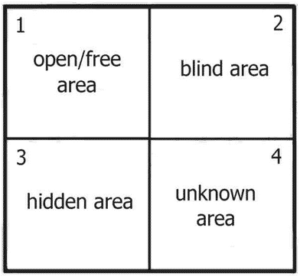What is the Johari Window & How to Use it

One of the tools that is beneficial for both team building and executive coaching is the Johari Window.
Do you have a good view through the Johari Window?
Or have you never even heard of this tool for developing and enhancing understanding and communication among team members and leaders?
What is a Johari Window?
The Johari Window was developed by Joseph Luft and Harry Ingham in 1955, while researching group dynamics, and is used today as feedback model for self-awareness—a critical need for any leader who wants to most efficiently relate and communicate to their team members and peers.
The Johari Window Model
The Johari Window comprises four panes, the first of which (in the top left corner) is described as the ‘Open’ area- those characteristics everyone knows about you.
On the top right is the ‘Blind’ area (the things you can’t see about yourself, but others can), and on the left below the ‘Open’ area is the ‘Hidden’ area (the things you know about yourself, but choose not to show others). In the bottom right is the area ‘Unknown’.
This is the area buried in your subconscious that if uncovered can uncover other areas of potential for you.
The Open Area
Also known as the free area, is where communication is open and free, with the least conflict. Well-developed teams often have a larger open area than those teams that are less established or have newer members; the more familiar people are with each other, the better they understand themselves and the people they work with.
The open area can best be utilized by expanding it further through deeper communication, such as in the blind area.
The Blind Area
The blind area extends horizontally from the open area. This region contains the traits that other people can see in you, but you may be too close to see.
With constructive feedback from trusted people and/or executive coaching, you or your team can be made aware of personality aspects that can hinder efficiency in work and communication.
The open area subsequently becomes larger and team cohesiveness expands accordingly, but can only be explored if you are willing to listen to how what other people perceive you.
The Hidden Area
This area extends vertically from the open area, because revealing it is not a matter between peers—it is instead an area you keep to yourself and have the power to reveal to others or not. That can include your agendas, sensitivities, and so on.
However, if some of this information is relevant to the situation, it is beneficial to reveal it. An office atmosphere where there is an aura of judgment or misunderstanding can keep that office an unsafe space, though, and keep people from sharing parts of themselves that could be helpful to the team.
If you wish to see people disclose their agendas and goals, or sensitivities that hinder their work, develop an office that is a safe space for all.
The Unknown Area
This area is filled with subconscious fears and motivations that are not easily seen by you or by the people around you.
There may be habits caused by childhood attitudes, undiscovered aptitudes, or other traits that affect your work or relationships without a clear cause or reason.
Unearthing relevant information or skills through effective coaching and questioning techniques can provide an individual with the opportunity to expand your potential by allowing your skills or those of your team members to be better communicated and utilized.
How can you and the team you lead benefit from identifying what lies in their Johari Window?
Category: Communication & Alignment
Tags: better work communication, communications, executive coaching, Johari window, team building


